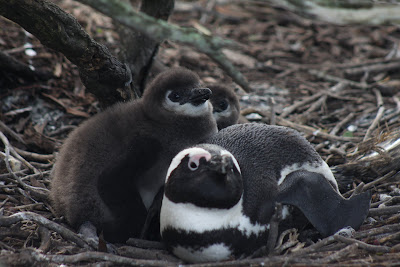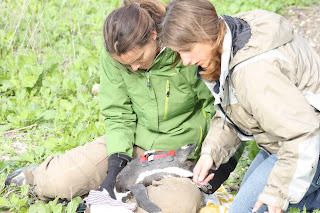GPS Logger Deployment
Global Positioning System Temperature Depth (GPS TD) Loggers were deployed on different breeding African penguins at Robben Island penguin colony in 2011, 2012 and 2013 . These devices receive signals from satellites and were set to take a GPS fix every minute in air if they received signals from 3 or more satellites and they take pressure and temperature data every second. Dr. Antje Steinfurth trained Kate Robinson in the proper deployment techniques. She showed how the penguin should be selected and handled during the process of logger deployment and retrieval. This research has University of Cape Town Animal Ethics approval and permitted under the Department of Environmental Affairs.
Here is is an explanation of the process on Robben Island:
Nest Selection
First a suitable nest must be found in the colony. On Robben Island, the amount of vegetation covering nests vary as well as the type of nest. Sometimes they are simply scapes or depressions in the soil, or they may be under dense rooikrans (an Australian bush) a natural borrow or an artificial burrow or nest box.
It is best to pick nests that have some form of cover yet are still accessible and easy to see into for logger deployments. The adult penguin at the nest is marked with a biodegradable non-toxic dye so it can be distinguished from its partner.
Monitor adult behaviour
The nest is re-visited to check that the adults are sharing parental care i.e. the adults are switching turns staying on the nest with the chicks while the other goes to the sea to forage for fish. Typically one adult will leave in the morning and return to the nest in the evening to feed the chicks. The parents continue to switch turns until the chicks start getting old enough to be left on their own. The bigger the chicks get the longer they are left on their own. When chicks get get old enough they leave the nest site and form groups of chicks called a creche. At this stage they have their juvenile plumage which looks blue.
When chicks are just a couple days old they need their parents to keep them warm as they can't thermo-regulate themselves. So we don't want to disturb adults with really small chicks. Once the chicks are a bit older they can be left on their own for short periods of time yet the adult still sits on them. Adult penguins with chicks that are at least 10 days old but that are still brooding their chicks are the best birds to deploy loggers on. If the adult penguin's chicks are the right size.in one of the nests that has been monitored, we ready the logger for deployment.
Preparing the logger device
The logger must be soldered with a new battery, programmed and then started and run outside. This is done so the GPS can make what is called a "warm start" meaning that it already has information of where satellites should be in the sky at the time when we have set the logger to start.
It has to run and find satellites for at least 15 minutes. Next, the logger is sealed with waterproof tape and wrapped in bubble wrap. All the the necessary materials are gathered up and we head out into the colony to the nest site.
Logger Deployment
The adult behaviour is observed before commencing the logger deployment. If the penguin shows any signs of stress or unusual behaviour then deployment is not carried out. A bird at another nest will then be selected for the deployment. Deploying a logger also requires good weather. If it rains the bird's feathers will be wet and the logger can't be attached.
If everything looks good to go all materials needed are set out and the waterproof tape is cut into strips ahead of time so that the penguin handling time can be as short as possible.
Gloves must be worn when taking the adult of its nest and care must be taken that the chicks do not run out. At least two people are needed: one to hold the penguin while the the other the deploys the logger. 'Deploying the logger' simply means attaching the logger correctly to the penguins lower back feathers with the strips of waterproof tape. The logger must be placed as far down the penguin's back as possible to minimize drag. It is useful to have a third person to watch the chicks and record the details of the deployment.
First, take the adult out of the nest. The penguin must be held from behind the head at the jaw bone and then also at the feet to keep them still. Gloves are worn by the person handing. You would be surprised how strong and fiesty a penguin can be. Their bills and claws aree sharp so care must be taken during the handling to keep the penguin and handler safe.
The person holding the penguin must sit on the ground and keep the penguin still and with its back straight for the deployment to be done quickly and efficiently.
The person doing the deployment must feel where the spine is then use a plastic pattern to help lift the correct amount of feathers to be stuck in layers to the waterproof tape sticky side up.
Once layers have been placed all the way down place the logger on top.
The tape is then rolled up around the logger.
Then the pattern is removed.
This is what it looks like at this stage.
Stips of tape are then placed length wise down the logger being careful to leave a window at the top exposed so the GPS can receive satellite signals.
A few dabs of glue to keep the waterproof tape in place.
The glue is smoothed out with a piece of tape to make it uniform and so it drys fast.
Some dirt is carefully sprinkled on top of any of the glue that is not dry so no leaves or vegetation will stick to the logger. The deployment of the logger is done.
The adult penguin with its logger 'backpack' is then placed back in its nest with its chicks and the field worker then backs away in a steady calm manner so the penguin remains in its nest with its chicks.
Return the next day cautiously to see if the adults have switched and the logger bird has gone to sea while the partner broods its chicks.
GPS Logger Retrieval
GPS loggers are devices which record location from the signals of satellites, pressure and temperature. After a penguin has gone to sea for one foraging trip with a logger the device must be removed in order for the data to be downloaded and collected. The nests are monitored closely in order to find the bird when it returns to its nest and retrieve the logger. If the bird does not return to its nest the logger eventually falls off as the waterproof tape degrades after several trips to sea. If we don't get the logger back we don't get the data so we always have our fingers crossed that the penguin will return to its nest after the foraging trip. The GPS loggers are expensive devices that can be re-programmed and deployed again on another adult penguin so it is important to get them back if we can. Once a penguin with a logger is found to have returned to its nest we remove it from the nest, quickly take the logger off and measure the bird.

Here an assistant holds the penguin while the waterproof tape is peeled off the logger and the logger is removed. After the penguin handling is over the logger is wrapped in bubble wrap and placed in a plastic box to keep it safe until we get it back to the research house to download the data.


After the logger is removed the tape is carefully peeled of the penguin's feathers.

After all the tape is removed, the penguin is quickly measured and then released back into its nest. We measure the penguin's culmen which is the length from the base of the upper mandible to the tip of the bill and the depth of the bill with calipers. Bill measurements give an indication of the size of the bird and it is thought this may be used to indicate the bird's sex. Then we weigh the bird using a scale and a strap. The penguin is then placed back in the nest with their chicks. Handling times are kept to a minimum. Photos courtesy of assistants Craig Harding and Dan Bentley.

























No comments:
Post a Comment